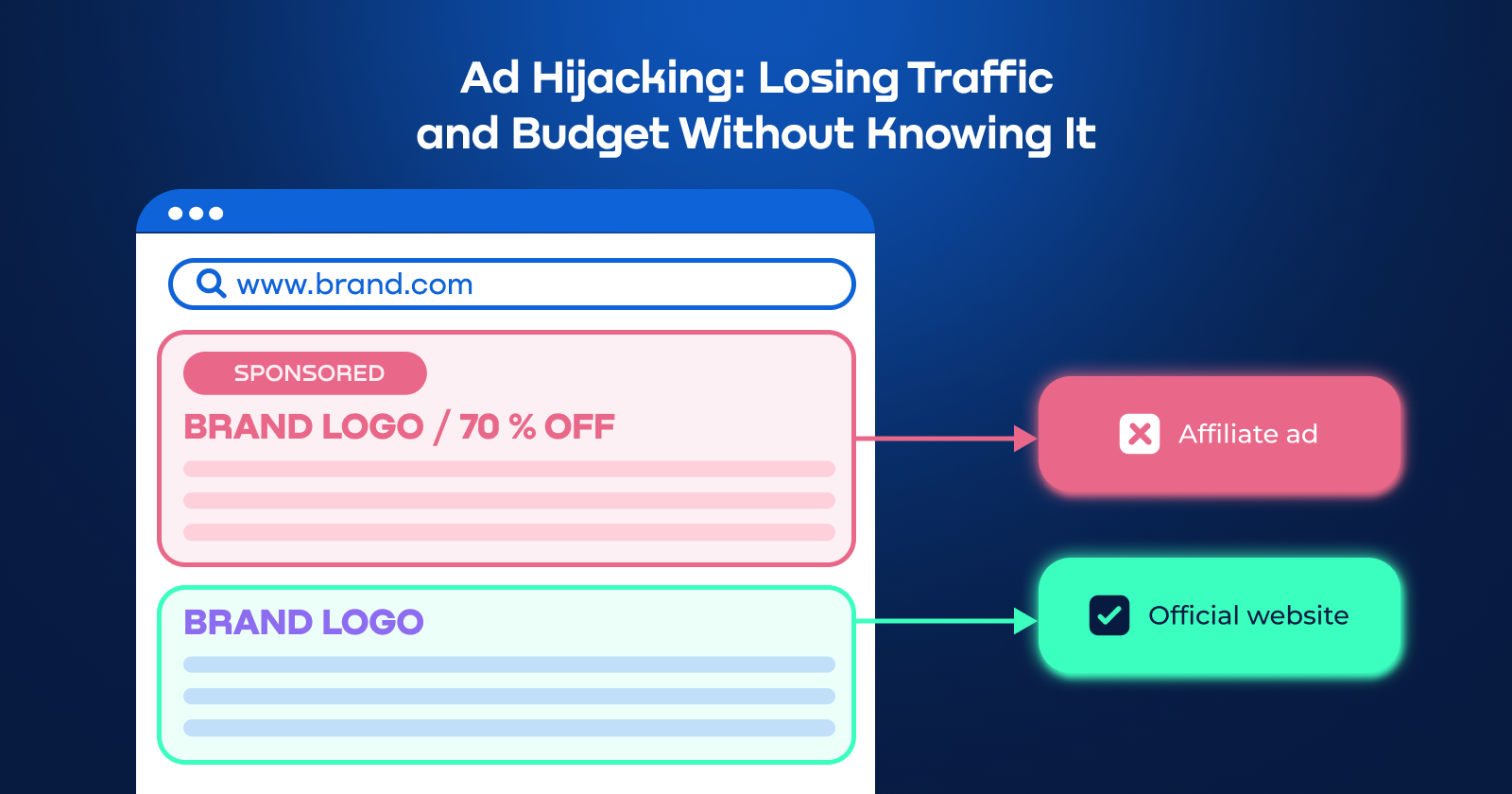This post was sponsored by Bluepear. The opinions expressed in this article are the sponsor’s own.
Have you ever seen an ad that looks just like your favorite brand’s ad, but isn’t? Ad hijacking.
Ever clicked an ad expecting to reach Nike’s website but ended up on some random store you’d never heard of? Ad hijacking.
It happens to thousands of companies that run paid ads, and you’re not immune.
More people are buying products and services online.
With $6 trillion being spent by online shoppers in 2024 (CapitalOneShopping Research), the competition for ad placement is fierce.
If someone hijacks your ads, you:
- lose traffic.
- lose money.
- lose trust.
Ad hijacking harms your brand and ad performance.
In This Guide:
Learn how to detect ad hijacking, stop affiliate abuse, and protect your traffic in 2025.
What Is Ad Hijacking?
Ad hijacking, by definition, is a form of advertising fraud where someone pretends to be your brand in paid search ads (like Google or other platforms). The fraudsters copy your brand name, your ad style, even your messaging, so the ad looks real.
But when a customer clicks, they’re sent somewhere else.
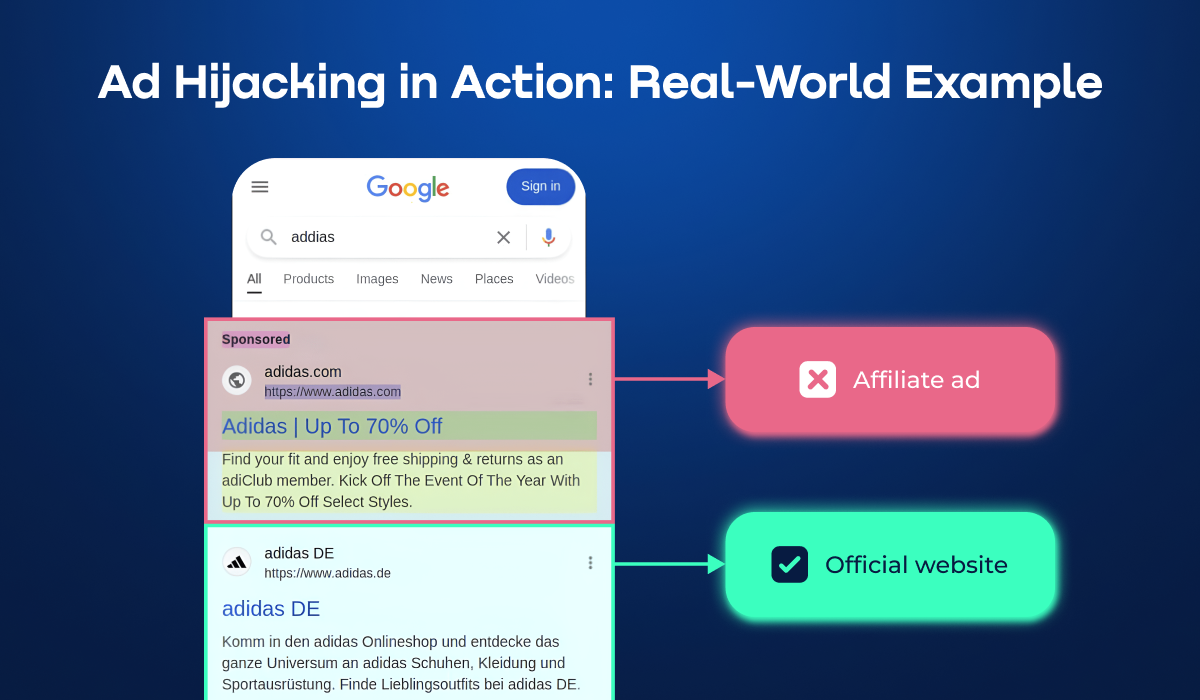 Image created by Bluepear, August 2025
Image created by Bluepear, August 2025There are two common types:
- Affiliate ad hijacking.
- Competitor ad hijacking.
What Is Affiliate Ad Hijacking?
Affiliate ad hijacking happens when partners in your affiliate program bid on your brand name.
They:
- copy your ad (same headline, same style) so it looks like the real thing.
The Result: The customer thinks they’re clicking on your official site because the ad looks the same. But behind the scenes, the affiliate redirects the traffic through their own tracking link.
You end up paying them a commission for a customer who was already looking for you. This inflates your costs, pollutes your data, and makes it harder to measure real performance.
Example: A user searches for [Super Tools]. An affiliate runs an ad with the headline “Super Tools Official Site,” but the link is an affiliate redirect. You pay them a cut, even though they didn’t bring in new traffic.
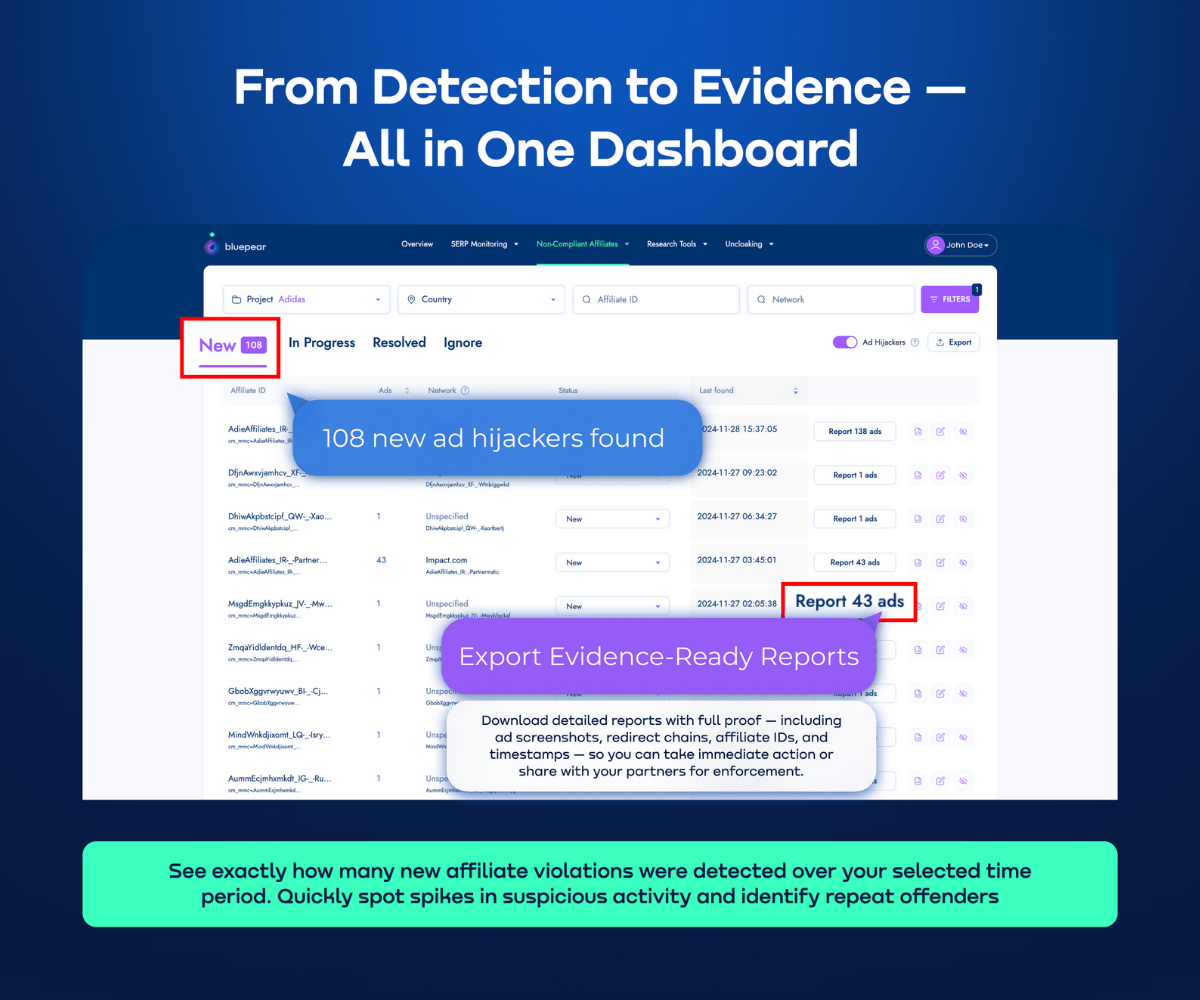 Image created by Bluepear, August 2025
Image created by Bluepear, August 2025What Is Competitor Ad Hijacking?
Competitor ad hijacking is when a rival company copies your brand in search ads to steal your traffic.
They:
- bid on your brand name,
- use ad text that looks like yours,
- sometimes even mimic your domain.
The Result: Customers click, thinking they’re going to your site. But instead, they land on the competitor’s website.
This tactic lets competitors capture high-intent traffic. As a result, you lose potential sales, while they gain market share. Without PPC brand protection, your brand presence can be weakened, allowing competitors to grow faster at your expense.
Example: A competitor bids on “Super Tools” and runs a lookalike ad. The user clicks, expecting your site, but lands on the competitor’s product page instead. You lose a sale and possibly the customer’s trust.
As you see, search hijacking is already a serious threat to your brand and budget. It’s made even worse by how well the violators hide their tracks.
Secret Tactics That Are Used To Hide Ad Hijacking
Non-compliant partners use smart tactics to avoid being seen by brand owners or their teams. Here’s how they do it:
- GEO targeting. Ads are shown only in specific countries, cities, or regions. If you’re not in that area, you’ll never see them – but your local customers will.
- Dayparting. Hijackers run ads at night, on weekends, or during holidays when your team is less likely to notice them.
- Cloaking and dynamic redirects. They use scripts to show one version of the ad or landing page to Google (to pass review) and a different one to users – usually a fake or affiliate redirect.
- Smaller search engines. Many hijackers avoid Google and run campaigns on Bing or other second-tier platforms, where rules are looser and tracking is weaker.
Without proper hijacking prevention, these tactics make it easy for hijackers to hide and hard for your team to catch them in time.
Direct Impact Of Ad Hijacking On Your Company
The impact of affiliate ad hijacking goes far beyond a few stolen clicks. It damages performance, costs money, and creates serious risks for your business:
- Lost ad budget. You pay commissions to affiliates who didn’t bring you new traffic; they just hijacked what was already yours.
- Higher CPC and more competition. Hijackers bid on your brand keywords, driving up your costs and competing against your own campaigns.
- Broken attribution. Without hijacking prevention, your analytics get messy. It becomes harder to measure what’s really working because affiliate hijacking inflates performance data.
- Reputation damage. Users may land on shady or misleading pages. They won’t know it’s not your site – they’ll just stop trusting your brand.
- Compliance risks. If you’re in a regulated industry (finance, health, etc.), fake ads and unapproved messaging can create legal trouble or policy violations.
Search hijacking doesn’t just hurt your numbers. It makes you question the data you rely on, wastes hours chasing false leads, and forces you to fight for traffic that was already yours.
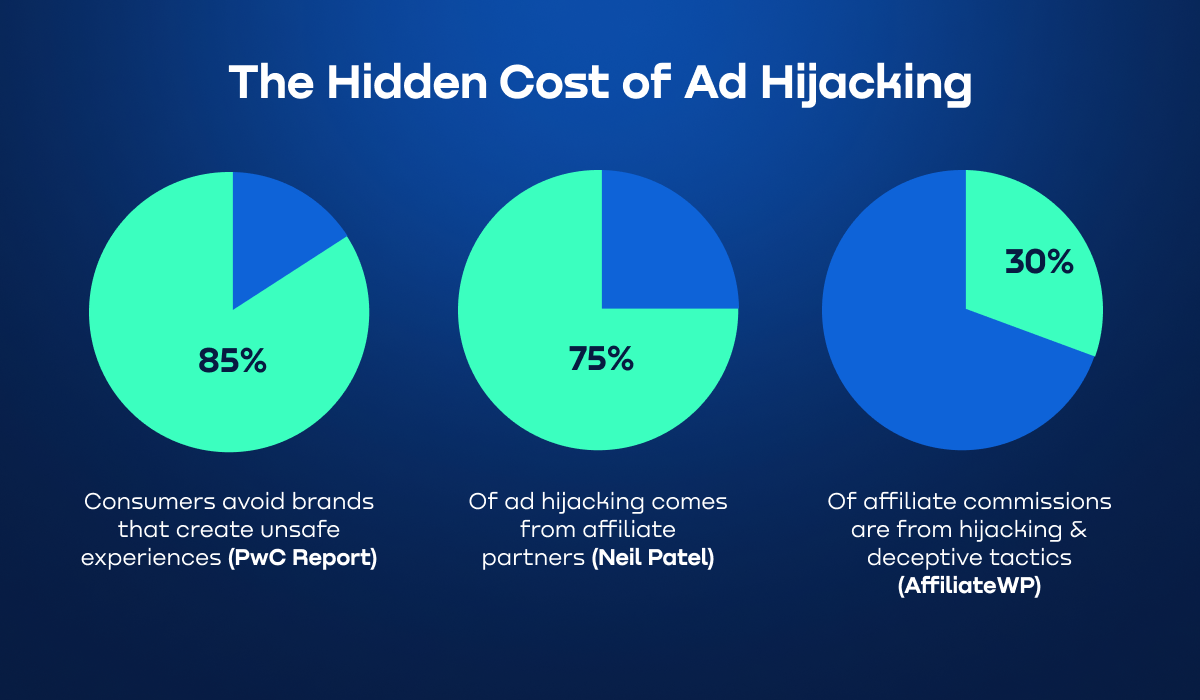 Image created by Bluepear, August 2025
Image created by Bluepear, August 2025- 85% of consumers avoid buying from brands that generate unsafe experiences, and ad hijacking falls into that bucket (PwC Report).
- 75% of ad hijacking comes from affiliate partners exploiting tracking gaps to earn unearned commissions (Neilpatel).
- Up to 30% of affiliate commissions come from hijacking and similar deceptive tactics (AffiliateWP).
- Ad hijacking caused an estimated $12.6 billion in losses in 2023, based on 15% of the $84 billion lost to ad fraud globally (Juniper Research).
How To Spot And Prevent Ad Hijacking
What actually works on PPC brand protection? To uncover real issues, you need tools and methods that go beyond surface metrics:
Step 1: Quick Manual Checks
- Run branded keyword searches and audit SERPs – look for near-identical copy linking to another domain.
- Watch for anomalies in performance (CPC spikes, conversion drops, affiliate surges).
- Review affiliate conversion patterns – unusual regional spikes may signal fraud.
- Geo-test with VPNs or third-party tools to uncover geo-targeted hijacks.
- Track impression share – sudden drops without budget changes mean new competition.
Step 2: Scalable Prevention Tactics
- Behavioral simulation: Mimic real user searches across devices and browsers to reveal hidden hijacks.
- Geo-rotation & proxy use: Detect localized hijacking attempts.
- Proof collection: Document ads, redirects, affiliate IDs, and keywords for enforcement.
- Real-time alerts & auto takedown: Get notified instantly and stop fraudulent ads before they drain your budget.
By combining manual checks and scalable tools, you can take control before search hijacking quietly eats into your ad spend.
Modern Tools To Catch What Manual Audits Miss
Manual checks can’t keep up with how ad hijacking works today. Hijackers often run ads only in certain regions, at non-working hours, or under specific conditions. They use cloaking and redirects that can’t be detected with regular checks.
Most teams lack the time and capability to ensure hijacking prevention through manual monitoring alone.
That’s why ad hijacking tools like Bluepear are essential – as PPC brand protection software, they automate continuous scanning of search results to catch every sneaky ad trying to hijack your traffic and budget.
Here’s how Bluepear helps to fight against ad hijacking:
- Simulates real user behavior. Bluepear mimics how actual customers search (using different devices, times, and locations) to trigger hidden hijack ads.
- Uncovers hidden redirects and de-cloaks landing pages. It follows the full click path to spot when a user is being secretly redirected or sent to a misleading page.
- Collects clear evidence. Every violation is logged with full details: screenshots, affiliate IDs, keywords, redirect chains – all in one report.
- Sends instant alerts and supports takedowns. When a hijack is detected, you get an alert right away. Bluepear provides clear evidence so that you can remove bad ads fast to stop further damage.
Ad hijacking tools aren’t an excess. If you want to survive in a world of smart fraud, automated PPC brand protection is a must.
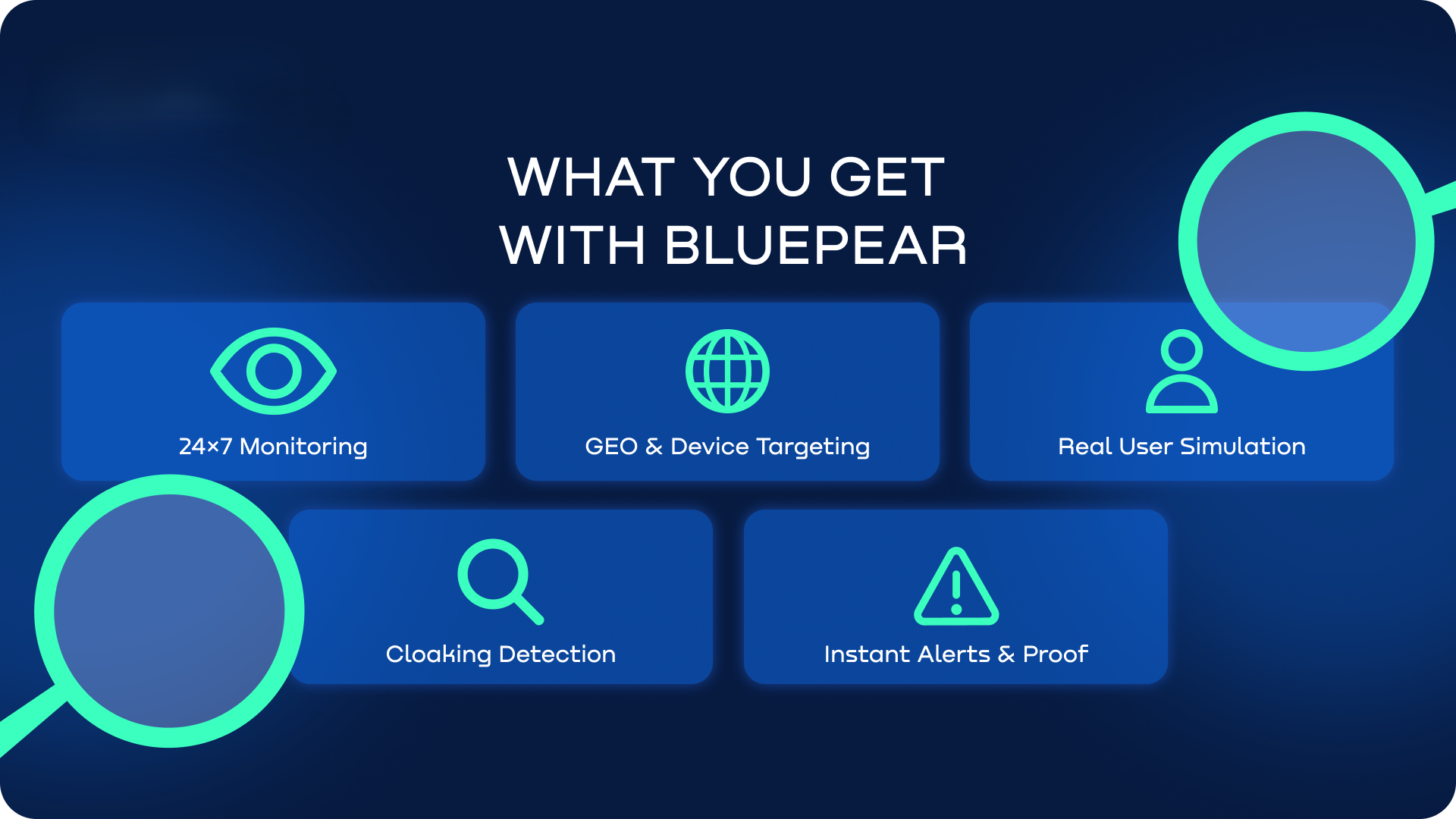 Image created by Bluepear, August 2025
Image created by Bluepear, August 2025Protect Your Brand From Ad Hijacking
Ad hijacking quietly eats into your ad budget, distorts your performance data, and damages user trust. Manual audits rarely catch it. Hijackers use GEO targeting, dayparting, and cloaking to stay hidden while stealing high-intent traffic and commissions.
Are you sure no one is hijacking your branded ads?
Bluepear helps you catch what others miss. The ad hijacking tool automatically checks SERPs from different GEOs, devices, and browsers to keep your brand protected from fraud.
Try Bluepear free for 7 days to see if your brand is being hijacked – and stop the budget loss.
Image Credits
Featured Image: Image by Bluepear. Used with permission.
In-Post Images:Image by Bluepear. Used with permission.

